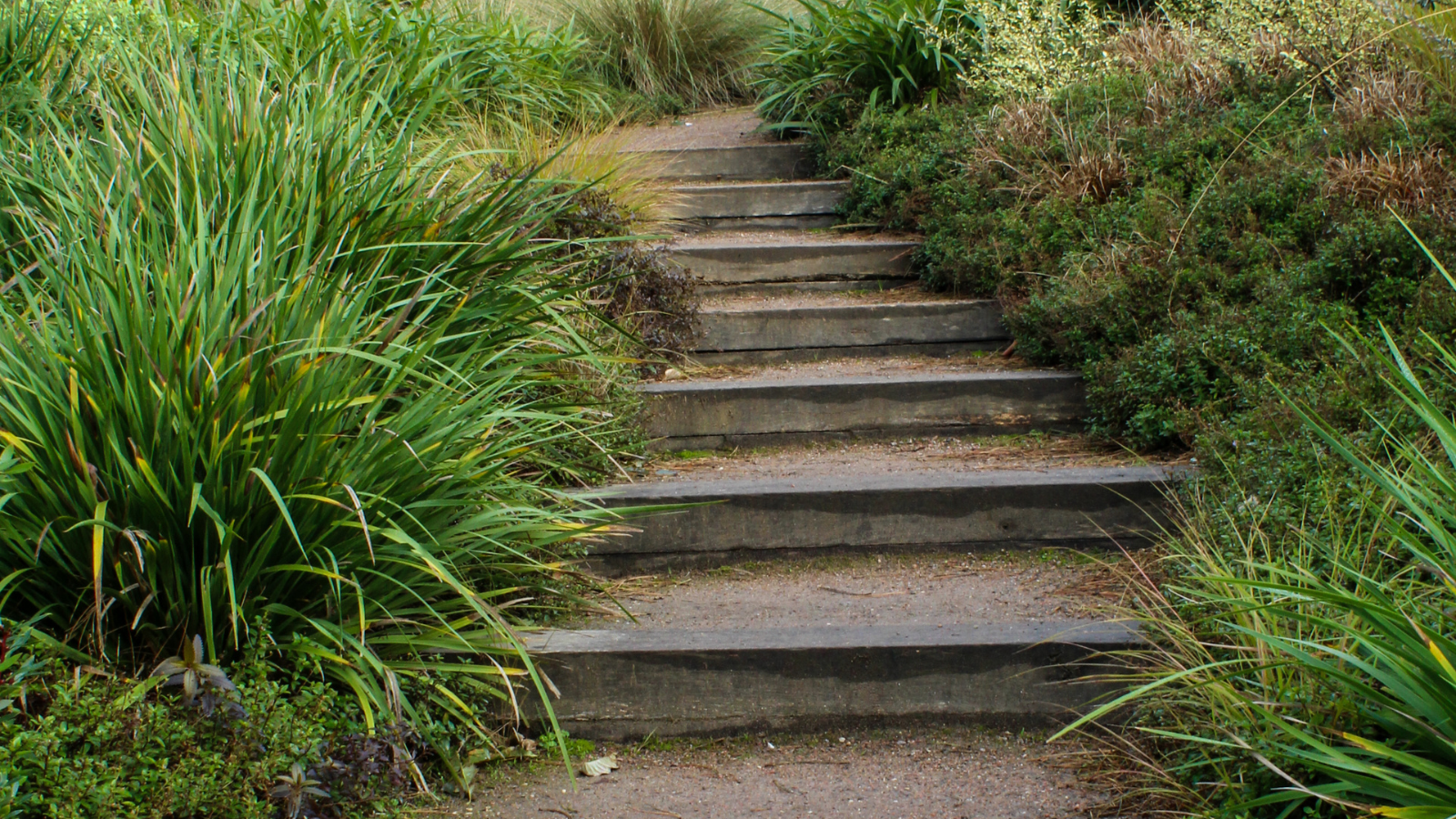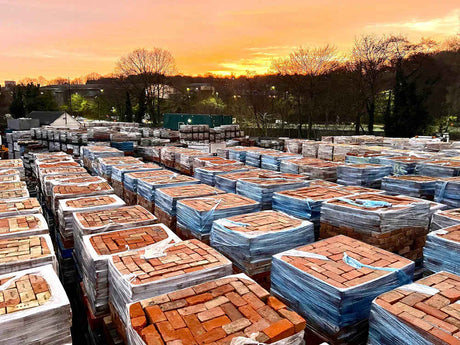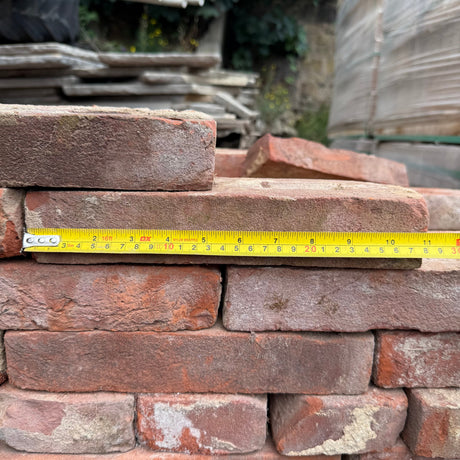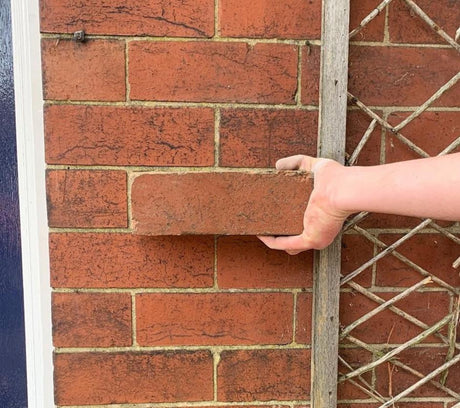Creating beautiful garden steps might pose some difficulty, especially if the aim is for an aesthetically pleasing and enduring design. This challenge is addressed with the use of railway sleepers as steps.
Known for their resilience and visual attraction, railway sleepers are an exemplary option for constructing long-lasting and visually appealing garden features.
An interesting aspect to bear in mind is that the use of timber in landscaping projects such as sleeper steps, can greatly improve your garden's total appearance and utility while being eco-friendly.
This guide will assist you with the successful and efficient construction of garden steps using railway sleepers. It covers exhaustive information from choosing the right materials to the upkeep of your beautiful new steps.
Continue reading; it's easier than perceived.
Why Choose railway sleepers as steps for Your Garden?
Selecting sleeper steps for garden landscaping brings unmatched durability and a unique aesthetic appeal. Railway sleepers, known for their robustness and longevity, ensure the steps in your garden can withstand harsh weather conditions, making them an ideal choice for both softwood and hardwood options.
These timbers offer a naturally appealing texture that blends seamlessly into outdoor spaces, creating visually striking features that enhance any garden design.
Sleeper steps marry form with function to craft timeless landscapes.
Moreover, using railway sleepers has significant environmental benefits. Opting for reclaimed sleepers contributes to recycling efforts by repurposing materials which would otherwise be wasted.
This practice supports sustainability in construction without sacrificing quality or beauty in landscape projects. Builders and homeowners alike favour these eco-friendly options as they make tangible contributions toward a greener planet whilst achieving the dream aesthetic of their outdoor spaces.
Advantages of Using railway sleepers in Your Garden
The utilisation of railway sleepers in your garden contributes numerous advantages. They inject a very rustic touch, charm and strong feel to exterior spaces, establishing them as perfect for crafting solid garden steps, elevated raised beds throughout, or unique landscaping attributes.
Sleepers exhibit incredible durability and can endure a range of weather circumstances, assuring your garden structures persist for many years. Their versatility permits architects, builders, and homeowners to slice garden sleepers up into various dimensions, rendering flexibility in design for custom garden projects.
The steps made from railway sleepers augment the aesthetic allure of a garden and also amplify its functionality. By establishing gentle steps on an incline or building extra wide steps for a separate patio entrance, you establish more secure and accessible outdoor regions.
Environmental boons incorporate reusing timber that could otherwise be wasted. Choosing either hardwood or softwood sleepers based on the requirements of your projects encourages sustainable building habits by utilising recycled materials that continue to offer maximum strength and resistance against decay when treated aptly.
Durability and Aesthetics of timber sleeper steps
Moving beyond the functional benefits of timber sleeper steps, let's explore their enduring quality and visual attractiveness. Timber sleeper steps prove their longevity, providing a practical tread reliable option for outdoor stairs.
They are made from hardwood sleepers known for resisting weather conditions. This resilience ensures that your garden steps stay strong and long-lasting, making them a suitable selection for both private homes and public landscapes.
Beyond their endurance, timber sleeper steps introduce a natural appeal to any garden environment. Their rustic look blends well with a variety of landscaping styles, from contemporary minimalist to classic cottage gardens.
By adding these wooden elements, you can construct unique staircases that serve a functional purpose and also heighten the visual interest of your outdoor space. With the appropriate treatment and care, timber sleeper steps retain their attractiveness over time, proving to be a perennial addition to any garden project.
Environmental Benefits of using railway sleepers
The incorporation of railway sleepers in your garden provides a rustic element along with significant environmental rewards. By selecting reclaimed railway sleepers as steps in, new timber's demand is decreased, thus reducing deforestation.
These sleepers, often crafted from enduring hardwoods like oak, pass through a long lapse of time on the railways and can continue for a substantial period in your garden with minimum treatment.
This long-lasting nature results in less waste going to landfill, assisting in diminishing our carbon footprint.
Reclaimed railway sleepers are a victory for your garden's visuals and the planet.
Furthermore, amalgamating these solid materials into landscaping endeavours like steps and retaining walls helps us moderate our dependence on newly procured materials that necessitate energy-demanding processes for production.
Electing for railway sleeper steps presents a green solution that doesn’t sacrifice quality or sturdiness; it promotes sustainable construction methods amongst architects, builders, contractors, interior designers, and homeowners.

What Materials Do You Need to build railway sleeper steps?
To build garden steps with railway sleepers, one must gather a variety of materials. Start with choosing the right railway sleepers for your project. New untreated sleepers are ideal for a fresh, natural look or choose reclaimed timber for added character and environmental benefits.
You will need different lengths based on the dimensions of your steps, so measure carefully before purchasing.
The tool list includes a circular saw to cut your sleepers to size, a spirit level to ensure each sleeper is level, and screws to fix your sleepers into place securely. Don't forget a wooden stake or stakes to drive into the ground directly behind each sleeper for extra stability.
For laying the foundation of raised beds, materials such as gravel for drainage and landscaping fabric to prevent weed growth are essential. Sand or concrete might be necessary if you plan to add concrete further on creating enough space for a more solid base underneath the sleepers.
Moving forward requires preparing the ground where these steps will lie.
Types of railway sleepers Available
Selecting the appropriate railway sleepers for your garden steps is critical. Each style offers unique advantages and aesthetics to suit various design tastes and functional needs.
-
Hardwood Sleepers: These sleepers are recognised for their durability and sturdiness, being long-lasting and weather-resistant. Varieties like oak or jarrah are commonly used, making them suitable for garden steps with heavy footfall.
-
Softwood Sleepers: These are preserved to combat decay and pest infestation, making them an economical choice for many. Softwood sleepers, sourced from pine or spruce, are lighter and more manageable compared to hardwood.
-
Reclaimed Railway Sleepers: These provide an earth-friendly alternative, reclaimed sleepers exhibit durability. Their unique history adds appeal and allure to garden designs. It's necessary to inspect for any harmful substances that might have been absorbed.
-
New Railway Sleepers: Being exempt from the wear and tear of reclaimed ones, new sleepers provide a streamlined look and uniform size that makes installation straightforward. They are ideal for contemporary garden designs.
-
Concrete Railway Sleepers: Though not as prevalent in garden designs as wooden ones, concrete railway sleepers provide unrivalled longevity and strength. They suit places where durability is more critical than aesthetical considerations.
-
Steel-Reinforced Railway Sleepers: Suited for sloping gardens where stability is crucial, steel-reinforced options blend durability with added support. These sleeper types ensure that each step remains secure despite ground shifting or heavy rain.
Choosing the right railway sleeper involves evaluating the desired visual impact as well as the practical needs for your garden steps project.
Necessary Tools for making garden steps
Building garden steps with railway sleepers requires precision and the right set of tools. Here is a comprehensive list of necessary tools to to build garden steps and ensure a successful project.
-
Measuring Tape: To accurately measure the length, width, and height of the area where the steps will be installed.
-
Circular Saw: For cutting sleepers to the correct size using a sharp blade to ensure clean cuts.
-
Spirit Level: Essential for ensuring that each step is level with the top of the stake and across its entire width.
-
Sledgehammer: Needed to drive wooden stakes into the ground securely behind each sleeper.
-
Drill with Screwdriver Bits: For fixing sleepers in place using screws long enough to create a sturdy structure.
-
Garden Spade: To dig out the basic step shapes and prepare the ground directly behind the sleeper.
-
Landscape Rake: Helps in levelling soil or gravel over which sleepers are laid, ensuring an even surface.
-
Wheelbarrow: For transporting materials like soil, gravel, and sleepers close to your working area.
-
Gloves and Safety Goggles: Always wear these for protection while cutting wood or handling rough materials.
-
String Line or Marking Paint: Useful for marking out your steps straight and aligned properly before excavation starts.
After gathering these tools, focusing on how to prepare the ground for your next few steps, becomes crucial for stability and longevity of your construction project.
Additional Supplies for laying sleeper steps
After gathering your tools for a few steps of making garden steps, it's essential to focus on the additional materials and supplies needed for extra wide steps and laying sleeper steps. These supplies ensure the longevity and stability of the wood preserve your steps, making your garden both beautiful and functional.
-
Landscape fabric: Line the steps with landscaping fabric to prevent weed growth and maintain the soil's integrity.
-
Gravel: A layer of gravel under each step aids in drainage and helps keep sleepers dry.
-
Concrete: Use concrete in the space behind each sleeper to fix them securely in place.
-
Wooden stakes: Drive stakes into the ground behind each sleeper for extra stability.
-
Spirit level: Essential for ensuring each sleeper is perfectly level.
-
Circular saw: Cut sleepers to the correct size using a circular saw, crucial for customising step sizes.
-
Tape measure: Measure the dimensions accurately to order the right amount of timber and supplies.
-
Drill and screws: Fix sleepers to wooden stakes or adjoining sleepers with durable outdoor screws.
-
Sandpaper or a power sander: Smooth down rough or cut ends of sleepers to prevent splinters.
-
Protective gear: Gloves and eye protection when cutting or drilling into sleepers.
-
Stain or wood protector: Apply to timber sleeper steps regularly to protect from weathering and rot.
-
Anti-slip material: Improve grip on your sleeper steps, especially important in wet conditions.
Each item plays a critical role in building durable, safe, and attractive garden steps that will last years, enhancing any outdoor space significantly.

How to build sleeper steps in Your Garden?
Building garden steps with railway sleepers introduces a timeless appeal to any outdoor area. This guide provides a straightforward method for architects, builders, contractors, interior designers, and homeowners looking to construct resilient and aesthetically pleasing sleeper steps.
-
Determine the most suitable type of railway sleepers for your plan. Hardwood sleepers are perfect for garden steps, given their hardiness and rot resistance.
-
Ascertain the dimensions of the site where you aim to construct the sleeper steps. Make sure you purchase the precise amount of timber and supplies.
-
Outline your steps using twine and pegs to designate where each step should be placed, assuring space for the sleeper and correct alignment.
-
Excavate the soil on each step approximately 15 centimetres below the sleeper's height to create a firm base.
-
Employ a spirit level to verify the flatness of the ground for each step that you're working on.
-
Set up a concrete bed or a packed gravel base underneath each sleeper to provide extra steadiness.
-
Position the sleeper atop this foundation, reassessing with a spirit level that it sits impeccably flat.
-
To fix each timber sleeper, you can either use concrete or wooden stakes pushed in behind each sleeper into the soil.
-
For sloping steps, ensure extra steadiness by fastening sleepers to stakes with strong screws or bolts to prevent movement over time.
-
Firmly pack the area behind each tread with soil or gravel.
-
Cover bare soil areas with gardening textile prior to filling, to deter weed infestation yet permit drainage.
-
If needed, heighten the traction of your sleeper steps by attaching anti-slip strips or mats on top of each tread.
Each step outlined here will aid in fabricating sturdy outdoor steps that not only exhibit charm but are also meant to withstand various weather conditions. This will offer additional materials for improved accessibility in your garden or outdoor space.
Step-by-Step Guide on building railway sleeper steps
Building garden steps using railway sleepers can utterly revamp your open-air area. Proper planning and precision are required to guarantee stability and durability sturdy outdoor steps.
-
Accurately measure the area designated for the sleeper steps installation. This procedure is vital for ordering the appropriate amount of timber.
-
Indicate your steps on the terrain you are constructing on, utilising stakes and string for precision.
-
Excavate trenches for each step, making certain they are a minimum of 10 centimetres lower than the sleeper that will rest on it. This depth offers stability.
-
Utilise a spirit level to ensure the earth in each trench is flat. This ensures each step is positioned uniformly and securely.
-
Place the sleeper atop the flattened earth in the trench. Recheck with a spirit level to ensure it is precisely horizontal.
-
Secure the sleepers by driving wooden stakes into the earth at both ends of each sleeper.
-
Securely fasten sleepers to the stakes using screws or nails of sufficient length to offer adequate support.
-
Fill the area behind each step with soil or gravel, ensuring it is well-compacted to resist settling over time.
-
For steps on an incline, ensure each step is securely rooted into the incline for added stability.
-
Apply landscaping fabric behind and beneath the sleepers if you aim to deter weed growth around your new steps.
-
Frequently verify that all sleepers maintain a level position and adjust as needed by adding or removing material underneath them.
-
As per preference, you could coat your railway sleeper steps with a protective layer to protect them from weathering and decay.
Each of these actions is vital for crafting visually delightful garden steps and also making sure they are sturdy and built to last for ages and can be used effortlessly by all without worry for safety or wear over time.
Tips to Ensure your sleepers are level
Ensuring your garden sleepers themselves are level is essential for the stability and aesthetics of your garden steps. Use a spirit level to check that each sleeper is flat and even before fixing it in place.
Start by situating the sleeper on the prepared ground. Adjust it until certain the sleeper is level from one end on firm ground to the other. Fill any gaps under the sleepers with soil or sand to avert shifting over time.
A spirit level doesn’t lie; always rely on its reading.
After the placement of one of building first sleeper and steps, position the next sleeper, with its front edge aligned accurately with the edge of the earlier one. This method ensures each step's uniformity, as well as helping to distribute weight evenly across all sleepers, increasing their overall strength and durability.
Securing the sleepers firmly succeeds this critical step.

Fixing sleepers in place Securely
To secure the two sleepers in place further, utilise concrete or wooden stakes driven behind each sleeper. This strategy ensures extra grip so that each step remains unwavering. Position the first sleeper atop add concrete or wooden stake on the compacted ground and utilise a spirit level for extra grip and leveling accuracy.
If concrete is your preferred choice, fill the space behind concrete bed and the sleepers with it for better stability.
Ensure the lip of the subsequent sleeper conceals the front edge of each step, promoting a fluid transition between steps. This technique not just augments stability but also bolsters user safety by eliminating tripping risks.
For advanced security, fill any spaces around sleepers with soil or gravel to keep them on firm ground and against potential shifts over time.
How to Prepare the Ground for garden steps using railway sleepers?
Preparing the ground for garden steps using railway sleepers is crucial for a stable and lasting structure. This process requires attention to detail to ensure each step sits level and firmly and is evenly spaced throughout.
-
Choose the location for your steps and clear the area of any debris, weeds, or large stones.
-
Use string lines and wooden stakes to mark out your steps, visualising how they will lie in your garden.
-
Measure the total height and depth you want your steps to achieve, considering the ideal size for garden steps.
-
Calculate the number of steps needed by dividing the total height by the height of one sleeper.
-
Dig into the ground on each step area, removing enough soil to accommodate the depth of the sleepers plus extra for bedding material.
-
Ensure that each dug-out step is well-compacted and level; use a spirit level to make this easier.
-
Position a sleeper at the front edge of each step, checking its levelness before fixing it in place.
-
Drive wooden stakes into the ground behind where each sleeper will go to provide additional support once fixed.
-
Install landscaping fabric behind each step's position to prevent soil erosion underneath them over time.
-
If building on sloped ground, ensure additional measures are taken to secure sleepers against shifting, such as embedding them deeper or using concrete supports driven in behind each sleeper.
-
Check that all sleepers are correctly aligned with one another; adjust as necessary before final fixing to maintain uniformity across all steps.
-
Once all sleepers are positioned and securely fixed, fill behind each with gravel or soil for stability and drainage.
Following these guidelines ensures your railway sleeper garden steps blend aesthetics with functionality, providing safe passage while enhancing your outdoor space’s appeal.
Marking Out Your steps
Marking out your steps is the first crucial step in how many steps when creating a pathway or transition in gardens, especially on slopes. Start by deciding how many steps and where each step will go to ensure a natural and comfortable rise.
Use wooden stakes to outline the position of each sleeper, stretching strings between them to mark both the width and depth of your steps. This process helps visualise the project's scope and ensures everything aligns properly before any digging starts.
A well-planned garden step begins with careful marking.
Next, measure the ground you are building on with a spirit level to make sure it’s even. For areas that aren't level, adjust by excavating soil or adding fill material beneath where sleepers will sit.
Doing so prepares for sleepers to be fixed securely in place, resulting in robust and age-resistant garden steps that all ages can use easily.

Excavating and Levelling the ground
After marking out your deep steps well, the next step involves excavating and levelling the ground. This crucial phase ensures that deep steps in each sleeper will rest on a stable and flat base, essential for the longevity of your garden steps.
Start by digging the soil to the depth needed for your steps to sit flush with the ground or at your desired height. The depth often depends on whether you want deeper steps or if you're fixing sleepers in a sloped area.
Levelling plays a key role in making sure your build railway sleeper steps are build sleeper steps that are safe and aesthetically pleasing. Use a spirit level to check the evenness of each trench before positioning your build railway sleeper steps on top.
Correct levelling prevents water from pooling around the sleepers and helps avoid uneven wear over time. If necessary, use either concrete or gravel at the bottom of each trench to aid in achieving optimal levelness and stability for every sleeper fixed in place.
Installing Landscaping Fabric
Lay the landscaping fabric on the levelled ground where you plan to install your sleeper steps. This fabric acts as a barrier, preventing weeds from growing through your steps while still letting water drain away.
Cut the fabric to fit each step area snugly. Secure it in place using garden pegs or staples, ensuring there are no loose areas that could lead to unevenness under the sleepers.
Position deeper steps of the sleeper directly on top of the secured landscaping fabric, making sure it all sits level and flush with the edges of your marked area. This method helps improve grip and stability for each sleeper step laid down.
Check each piece is level before fixing it into position with wooden stakes or screws evenly spaced at regular intervals along its length. This process ensures every sleeper firmly beds into place without shifting, creating durable and stable garden steps built to last.
How to Maintain Your railway sleeper steps?
Maintaining your railway sleeper steps ensures they remain safe and visually appealing. Regular upkeep prevents weather damage and prolongs their life.
-
Inspect your sleeper steps every six months to check for signs of rot or insect damage. Look especially at areas where water might collect.
-
Fix any sleepers that show signs of movement or instability. Use wooden stakes or braces to secure them in place.
-
Apply a wood preservative annually to protect the timber from rot and pests. Make sure the ground around the sleepers drains well to avoid waterlogging.
-
Clean the steps regularly with a brush to remove mud, moss, and algae. This step improves grip and prevents slips.
-
Sand down rough spots on the sleeper surface to prevent splinters and keep the steps comfortable for walking barefoot.
-
Position a sleeper on top if noticeable gaps form between steps, ensuring it is level and secure.
-
Ensure each top of the sleeper has sufficient overhang over the lip of the next sleeper to ensure rainwater runs off correctly.
-
Check that all steps are deep enough for comfortable use, adjusting as necessary by adding more material under or behind sleepers.
-
Improve the grip of your sleeper steps by adding anti-slip mats or strips, especially important in wet or frosty conditions.
-
Regularly trim grass and plants around the edges of your railway sleeper steps to maintain clear visibility and access.
Following these maintenance tips helps keep your garden looking great while ensuring each step is robust and built to last.
Protecting timber sleeper steps from Weather
To protect timber sleeper steps from weather, it's crucial to apply a wood preservative. This treatment prevents rot and extends the life of your sleepers. The process involves covering all surfaces with a high-quality, wood preserver protector right after installation.
For best results, reapply the preservative every two years. Also, placing the sleepers on top of a gravel bed improves drainage and prevents water from pooling. Ensure any space under the steps is clear for air to circulate freely.
Another key step is ensuring that your sleeper fixings are made of galvanised steel or another rust-resistant material. These materials prevent corrosion from rainwater and moisture in the soil.
Regular inspections help catch any issues early on, such as loosening screws or signs of wear and tear at points where sleepers come into contact with each other or with different materials.
Fixing any sleepers immediately when damage occurs keeps them secure against harsh weather conditions.
Regular Inspections and Repairs
Performing habitual assessments and repairs is critical for upholding the durability of the wooden railway sleepers and the building sleeper steps. The wooden railway sleepers sturdy outdoor building sleeper steps should be examined for signs of wear, such as decay or insect impairment, and rectify these issues right away if they appear.
Carefully maintain an aligned position for each sleeper; this helps secure safety and enhances their longevity. Utilising wooden stakes can assist in setting sleepers steadfastly, averting displacement that could induce misalignment or instability eventually.
Consistent upkeep is instrumental in preserving the utility and allure of garden steps.
To prevent weeds and further inhibit degradation, shield exposed wood surfaces with suitable treatments. This preventative step defends against weather-related harm and assists in upholding the timber's aesthetic charm.
If build garden steps have become imbalanced due to settling or erosion, rearrange the sleeper atop a rectified base. This tactic aids in keeping your garden steps secure and visually enticing while guaranteeing they assimilate effortlessly into their natural milieu.
Enhancing the Grip of your sleeper steps
To enhance the grip of the wood preserve your sleeper steps, apply a non-slip paint or varnish specifically designed for outdoor timber. These products contain granules that provide extra traction underfoot, making the steps safer in wet and slippery conditions.
Homeowners should choose a product with UV protection to prevent fading and ensure longevity. Regular application according to the manufacturer's instructions can maintain effective grip over time.
Installing metal or rubber tread covers on each step is another effective method. These covers fix directly onto the timber surface, offering immediate improvement in grip. They are particularly useful in areas prone to ice or heavy rain.
Both methods improve safety without compromising the aesthetic appeal of railway sleeper steps, ensuring they remain an attractive feature in any garden design.
Can You build railway sleeper steps on a Slope?
Building railway sleeper steps on a slope presents certain challenges but also offers effective solutions. The key lies in ensuring stability and safety throughout basic step shapes the construction process.
First, you must excavate the area to create a stable base for each step. Using wooden stakes, fix the sleepers into position by driving the stakes into the ground at both ends of each sleeper.
This method secures them firmly in place, preventing movement.
Ensuring that each sleeper is level becomes crucial as you progress up or down the slope. To achieve this, use a spirit level when positioning each sleeper on top of the prepared base.
Fill behind each step with soil or gravel to enhance stability and drainage, covering by the lip ensures that materials do not spill over onto the garden building sleeper steps themselves. Following these best practices will help architects and builders successfully create functional and attractive garden building sleeper steps, even on challenging sloped gardens.
Challenges and Solutions for steps on a slope
Creating steps on a slope presents unique challenges. One major issue is ensuring the stability and safety of the steps. To tackle this, one must position the sleeper precisely where it will rest.
This involves careful measuring and adjusting to make sure the sleeper is level before securing it in place. It's crucial to dig into the slope with enough space for each step to fit snugly against the soft or rocky ground, which prevents shifting or sinking over time.
Solutions include using landscaping fabric behind each step to prevent weeds and discourage erosion underneath them. Another approach involves ordering the correct amount of timber for your project, as having too little or too much can complicate construction on uneven terrain.
Proper drainage is also vital; install a small gravel bed beneath each sleeper to prevent water from pooling under your steps and potentially undermining their stability over time.
Ensuring Stability and Safety
Ensuring stability and safety requires precise steps during construction. You must position the sleeper on top of a stable base to prevent movement. This involves digging into the soft or rocky ground at the correct depth for each step, ensuring a firm foundation.
Securely fixing sleepers in place is crucial for long-term durability. Use screws or brackets designed for outdoor use to resist weathering.
For sloped gardens, stability becomes even more critical. A thorough assessment of the slope ensures that steps are built to accommodate natural land contours without risking shifting over time.
The lip of each step should cover the back end of the lower sleeper, creating an interlocking effect that enhances both strength and safety. Regular inspections help catch any potential issues before they become serious problems, keeping your garden safe for everyone who uses it.
Best Practices for Sloped Gardens
Building steps on a slope presents unique challenges, but with precise planning, one can ensure stability and safety. Start by assessing the degree of the slope to order the correct amount of timber and railway sleepers needed for your garden steps.
Use sturdy railway sleepers known for their durability in landscaping projects. For sloped gardens, digging into the hillside creates natural tiers. This method secures each step firmly into the ground, reducing slip hazards.
To maintain these garden steps over time, cover them with a lip at the back edge. This small detail stops soil from washing onto the stairs when it rains. Regular inspections help catch any wear before it becomes dangerous.
The right preparation transforms sloped gardens into stunning and practical landscapes.

Conclusion
Constructing garden steps from railway sleepers transforms your outdoor space. You've now seen the benefits, materials needed, and a guide to building them. These steps from untreated sleepers not just enhance garden aesthetics but are also durable and environmentally friendly.
Are you ready to tackle this project in your own garden? With the right tools and supplies, it is simpler than you might think. Your sloped garden areas can become accessible and visually appealing.
Let's bring those sleeper step designs to life with confidence!








